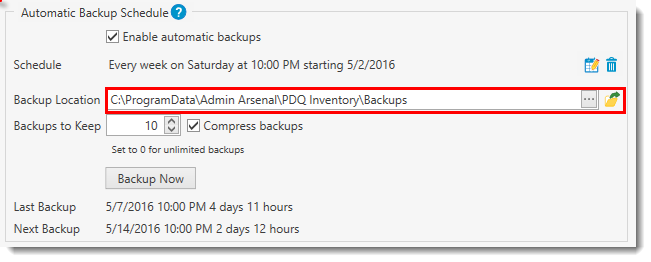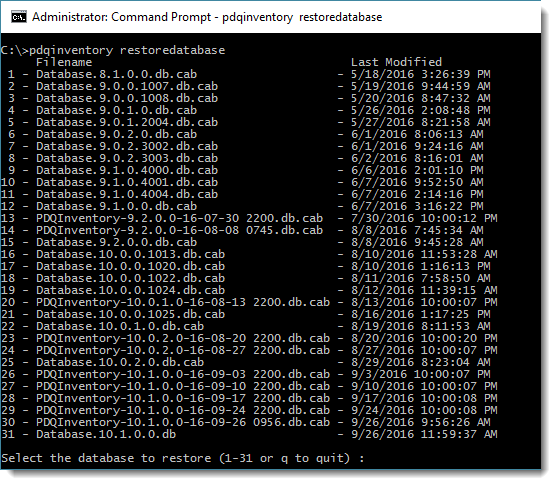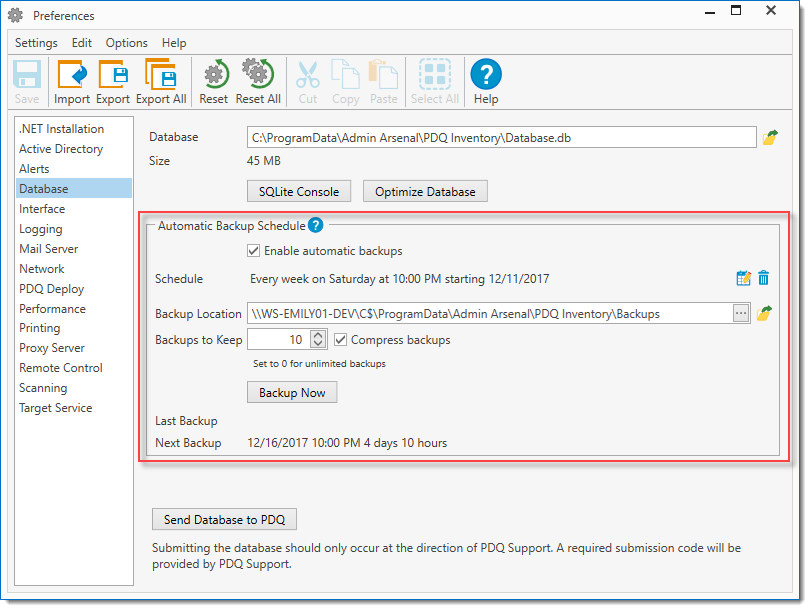PDQ Inventory stores all of its data—collections/reports, computer inventory information, Active Directory information, preferences settings, etc.—in the PDQ Inventory database. This SQLite database is required for the program to function.
By default, the database file, database.db, is stored in the %ProgramData%\Admin Arsenal\PDQ Inventory folder.
NOTE: %ProgramData%, was introduced in Windows Vista and used in subsequent Operating Systems (Windows 7, 8.x, 10, etc), and is a folder designed to hold application-specific (that is, not user-specific) data. By default, Windows marks this folder as hidden. Its default location is %SYSTEMDRIVE%\ProgramData. If you are running PDQ Inventory on Windows XP or 2003 (no longer supported), the default location is %SYSTEMDRIVE%\Documents and Settings\All Users\Application Data.
The PDQ Inventory database is made up of the following files:
File |
Description |
Database.db |
This is the main SQLite database file that holds all of the computers, inventory, collections, reports, etc. |
Database.db-shm Database.db-wal |
These files are used by SQLite while accessing the database. They can be deleted without affecting the system as long as no applications or services are accessing the database. If you move PDQ Inventory to another computer, they don't need to be copied to the new computer with the database file, but it won't hurt if they are. However, if you restore a database backup file, you must delete these files; otherwise, PDQ Inventory will think the restored database file is corrupted. |
The database file, database.db, is not removed on uninstall in case the software is reinstalled. If you move PDQ Inventory to another computer, the PDQ Inventory database must be duplicated on the new computer in order to maintain your PDQ Inventory settings and system data. For detailed information on this procedure, see Moving PDQ Inventory to a New Computer.
•Restoring Database Backup Files
•Restoring a Database using a Command Prompt
•Maintaining the PDQ Inventory Database
Database Security
Security is very important to PDQ. To that end, we encrypt sensitive information (passwords) when they are stored in the PDQ Inventory database. We use industry standard AES encryption with three separate keys to keep your data safe. One key is built into the application, one key is stored in the database, and the third is stored in the registry. These last two keys are generated when the application is installed and are unique to your system.
Our support staff may ask you to upload your database to us in order to troubleshoot a problem. No sensitive data (for example, passwords or encryption keys stored in the registry) will be sent to PDQ and all data is transmitted over a secure SSL connection, so you can be sure that your passwords are kept secure.
If you need to move your database from one computer to another you should include the encryption key in the registry. (For detailed information on this procedure, see Moving PDQ Inventory to a New Computer.) If the key is lost, then all passwords stored in the database will need to be re-entered. No other data is lost.
Database Backup Files
Each time you install a new version of the PDQ Inventory software, a database backup file is created in the %ProgramData%\Admin Arsenal\PDQ Inventory\Backups folder. The backup file is compressed and is named after the version of the database. For example, Database.6.2.0.0.db.
NOTE: The database version numbers represent the exact version of PDQ Inventory at the time of backup. For example, when upgrading Inventory 6.2.0.0 to 7.1, the existing database is copied to a file called Database.6.2.0.0.db and then, after a small interval, it is archived in the .cab format.
Older backup files can be safely deleted, but you may want to keep the most recent backups in case you need to restore the database.
Restoring Database Backup Files
In the event that your database is deleted or corrupted, you can restore a database backup file.
Locate the backup database file you wish to restore:
1.Click Options > Preferences (or press Ctrl+Comma), then select Database.
2.The backup location of the database is specified in Backup Location. By default, the backup database files are located in %PROGRAMDATA%\Admin Arsenal\PDQ Inventory\Backups.

3.Navigate to the directory indicated in Backup Location or click the Open Folder Location ![]() button.
button.
4.Locate the backup file from which you wish to restore. The backup file is named after the version of the database with the date and time the backup was performed. For example, a backup of version 9 performed on March 23, 2016 at 2:32 PM will be titled PDQInventory- 9.1.0.0-16-03-23 1432.db.cab.
Restore the database from the backup:
1.Decompress the database backup file.
Most compression utilities, such as WinZip and 7-Zip, can decompress cabinet files.
2.Rename the file to Database.db or create a copy of the original file and rename it to Database.db.
3.Stop the PDQ Inventory Service.
This is done in Options > Background Services. Alternately, you can access services through the Windows Start Menu > services.msc.
4.Overwrite the existing database file in folder %ProgramData%\Admin Arsenal\PDQ Inventory.
5.Delete the Database.db-shm and Database.db-wal temporary files.
WARNING: If you do not delete these files, PDQ Inventory will think the restored Database.db file is corrupt.
6.Start the PDQ Inventory Service.
This is done in Options > Background Services. Alternately, you can access services through the Windows Start Menu > services.msc.
Restoring a Database using a Command Prompt
IMPORTANT: This does not restore PDQ Inventory to a different version, this only restores the database.
To restore the PDQ Inventory database from a Command Prompt:
1.Run cmd.exe as Administrator.
2.To view the options available when restoring the database, use the following command: PDQInventory.exe RestoreDatabase.
 |
3.Enter the number of the database you wish to restore.
4.(Optional) To automatically restore the most recent database, use the following command: PDQInventory.exe RestoreDatabase -RestoreMostRecent. The database being overwritten will be renamed and left in the same folder.
Maintaining the PDQ Inventory Database
PDQ Inventory stores all of its data—collections/reports, computer inventory information, Active Directory information, preferences settings, etc.—in an SQLite database file. The PDQ Inventory database is essential to run PDQ Inventory; therefore, it is recommended that you perform the following regular maintenance procedures to ensure optimal database performance:
•Location of the PDQ Inventory Database
•Backing Up the PDQ Inventory Database
Location of the PDQ Inventory Database
PDQ Inventory stores its database locally (on the PDQ Inventory console computer) in %ProgramData%\Admin Arsenal\PDQ Inventory.
NOTE: %ProgramData%, was introduced in Windows Vista and used in subsequent Operating Systems (Windows 7, 8.x, 10, etc), and is a folder designed to hold application-specific (that is, not user-specific) data. By default, Windows marks this folder as hidden. Its default location is %SYSTEMDRIVE%\ProgramData. If you are running PDQ Inventory on Windows XP or 2003 (no longer supported), the default location is %SYSTEMDRIVE%\Documents and Settings\All Users\Application Data.
If your console performance is lagging during scans, you may consider moving the PDQ Inventory database to a faster disk. For information on this procedure, visit the PDQ.com Support page at https://support.pdq.com/home and click Submit a Request or email your request directly to support@pdq.com, or click Help > Submit Feedback. You can also browse the PDQ.com forums for FAQs.
Backing Up the PDQ Inventory Database
Because the PDQ Inventory database stores all collections, reports, and computer inventory information, it is highly recommended that you regularly backup the PDQ Inventory database. Since the SQLite database is a single file, this is easy to accomplish. You can setup an Automatic Backup Schedule in the Database page of Preferences. The default backup schedule is weekly on Saturdays at 10:00 PM. The default will also retain 10 compressed backups.
By default, the PDQ Inventory database is located at %ProgramData%\Admin Arsenal\PDQ Inventory\Database.db. To protect your system data, configure your backup software to regularly back up this file.
NOTE: To determine the location of the PDQ Inventory database, click Options > Preferences or press Ctrl+Comma, then select Database. The Database field displays the path and filename for the PDQ Inventory database. The backup location displays the path and filename for the backup database files.
To change the PDQ Inventory database backup defaults, perform the following:
1.Click Options > Preferences or press Ctrl+Comma, then select Database.
2.Make the appropriate changes in the Database Preferences window:

Option |
Description |
|
Enable automatic backups |
Enables the PDQ Inventory automatic backups feature. This is enabled by default. |
|
Schedule |
Displays the current schedule for the automatic backup. Clicking the Edit Schedule Note: If no schedule is selected, a backup will not be performed regardless of whether Enable automatic backups is selected. A warning at the bottom of the Automatic Backup Schedule section will notify you if this is the case. |
|
|
Once |
Schedule once in the future. •Trigger On: Date the trigger will run. •At: Time the trigger will run. •Description: (Optional) Description of the trigger. |
Interval |
Backs up (and repeats) at a set time interval. •Every: The interval by day, hour, and minute. •Only run during the following time frame (Optional) Enables a set time frame. •Between: The start of the time frame. •And: The end of the time frame. •Starting: Date the trigger starts. •At: Time the first trigger starts. If the optional time frame is selected, the first trigger will occur at the start of the next time frame. •Ending: (Optional) Date the trigger ends. Leaving this unchecked will allow the trigger to run indefinitely. •At: (Optional) Time the trigger ends. •Description: (Optional) Description of the trigger. NOTE: Setting the 'Between' time later than the 'And' time will result in the trigger running overnight. |
|
Daily |
Backs up every day at the same time. •Every Day At: •Time the trigger will run. •Starting: Date the trigger starts. •Ending: (Optional) Date the trigger ends. Leaving this unchecked will allow the trigger to run indefinitely. •Description: (Optional) Description of the trigger. |
|
Weekly |
Backs up every week at the same time on selected days of the week. •Every Week On: •Day (or days) that the trigger runs. •At: Time the trigger will run. •Starting: Date the trigger starts. •Ending: (Optional) Date the trigger ends. Leaving this unchecked will allow the trigger to run indefinitely. •Description: (Optional) Description of the trigger. |
|
Monthly |
Backs up every month at the same time on selected days. •Every Month •Day of the Month: The actual day (or days) of the month (for example, 1, 12, 23, etc.). If you select the 29th, 30th, or 31st of the month, the trigger won't run in months without those days. Select Last to always run the trigger on the last day of the month. Or •Day of the Week: The nth day of the month (for example, First Monday, Second Wednesday, Last, etc.). Different combinations of weeks and days require separate schedules (for example, the 1st Monday and the 2nd Friday). Selecting the 5th week won't run the trigger in a month without a fifth week. Select Last to always run the trigger on the last week of the month. •At: Time the trigger runs. •Starting: Date the trigger starts. •Ending: (Optional) Date that the trigger ends. Leaving this unchecked will allow the trigger to run indefinitely. •Description: (Optional) Description of the trigger. TIP: Days of Month: If you select the 29th, 30th, or 31st of the month, the backup won't occur in months without those days. Use Last to always deploy on the last day of the month. Can be mixed with Weeks of the Month. TIP: Weekdays/ends of Month: Different combinations of weeks and days are not available (for example, the 1st Monday and the 2nd Friday.) Selecting the 5th day(s) won't deploy in a month without a fifth week. Use Last to always deploy on the last week of the month. Can be mixed with Days of the Month. |
|
Backup Location |
Displays the path where backup files are stored. The default location is C:\ProgramData\Admin Arsenal\PDQ Inventory\Backups. Click the Open Folder Location NOTE: The backup file is named after the version of the database with the date and time the backup was performed. For example a backup of version 9 performed on March 23, 2016 at 2:32 PM will be titled PDQInventory- 9.1.0.0-16-03-23 1432.db.cab |
|
Backups to Keep |
Specifies the number of most recent backup files to keep. Setting this to 0 will save all backups. The default setting is 10. |
|
|
Compress backups |
Automatically compresses each backup to save space. This is enabled by default. |
Backup Now |
Backs up immediately instead of waiting for the next scheduled backup. |
|
Last Backup |
Displays the date and time of the last database backup as well as how long ago the backup was performed. |
|
Next Backup |
Displays the data and time of the next backup as well as how long until the next backup is performed. |
|
Optimizing the Database
When PDQ Inventory deletes information from the PDQ Inventory database, it leaves empty space in the database file which takes up a few bytes. Over time, this space adds up and may impact database performance. Therefore, it is recommended that, on average, you optimize the PDQ Inventory database once a month. Optimizing the database frees up the empty space and gets rid of fragmentation.
NOTE: Optimizing the database stops the background service. Any outstanding scans will be aborted so take care to only optimize the database at appropriate times.
NOTE: PDQ Inventory automatically optimizes the database when the application is upgraded.
To optimize the PDQ Inventory database:
1.Click Options > Preferences or press Ctrl+Comma.
2.In the Preferences menu, click Database.
3.Click Optimize Database.
PDQ Inventory warns that the console and background service will be stopped, which will abort any running scans.
4.Click OK to continue.
PDQ Inventory opens a command line window to run the optimization command.
5.When the optimization completes, press Enter to close the command line window.
PDQ Inventory automatically restarts and opens the Preferences window.
6.Click Close.
© 2020 PDQ.com Corporation. All rights reserved.
PDQ.com is a trademark of PDQ.com Corporation. All other product and company names are the property of their respective owners.
Help Version: 19.0.40.0